Design, Challenges and Developments for 5G Massive MIMO Antenna Systems at Sub 6-GHz Band: A Review
Abstract
:1. Introduction
2. 5G Massive MIMO at Sub-6 GHz
2.1. 5G Massive MIMO Antennas for BS Applications
2.1.1. 2D Massive MIMO
2.1.2. 3D Massive MIMO
2.1.3. Combined (Sub-6 GHz/MM Wave) mMIMO
2.2. 5G Smartphone mMIMO Array Antenna Techniques
2.2.1. 18-Port 5G Massive MIMO
2.2.2. 12-port 5G Massive MIMO
2.2.3. 10-Element 5G Massive MIMO
2.2.4. 8-Element 5G Massive MIMO
2.2.5. 4-Element/8-Port 5G Massive MIMO
3. 5G Antennas as a Candidate for Massive MIMO Technique at Sub-6 GHz
3.1. Single Elements
3.1.1. 3D-Model Antennas
3.1.2. 2D-Model Antennas
3.2. Sub-Arrays
3.2.1. Symmetric Array
3.2.2. Non-Symmetric Array
4. Challenges and Future Directions
5. Conclusions
Author Contributions
Funding
Data Availability Statement
Conflicts of Interest
References
- Pant, M.; Malviya, L. Design, developments, and applications of 5G antennas: A review. Int. J. Microw. Wirel. Technol. 2022, 1–27. [Google Scholar] [CrossRef]
- Jain, A.; Yadav, S.K. Design and analysis of compact 108 element multimode antenna array for massive MIMO base station. Prog. Electromagn. Res. C 2016, 61, 179–184. [Google Scholar] [CrossRef] [Green Version]
- Rahayu, Y.; Sari, I.; Ramadhan, D.; Ngah, R. High gain 5G MIMO antenna for mobile base station. Int. J. Electr. Comput. Eng. 2019, 9, 468. [Google Scholar] [CrossRef]
- Kumar, S.; Dixit, A.; Malekar, R.; Raut, H.; Shevada, L.K. Fifth generation antennas: A comprehensive review of design and performance enhancement techniques. IEEE Access 2020, 8, 163568–163593. [Google Scholar] [CrossRef]
- Borges, D.; Montezuma, P.; Dinis, R.; Beko, M. Massive mimo techniques for 5g and beyond—Opportunities and challenges. Electronics 2021, 10, 1667. [Google Scholar] [CrossRef]
- Ikram, M.; Sultan, K.; Lateef, M.; Alqadami, A.S.M. A Road towards 6G Communication—A Review of 5G Antennas, Arrays, and Wearable Devices. Electronics 2022, 11, 169. [Google Scholar] [CrossRef]
- Farasat, M.; Thalakotuna, D.; Hu, Z.; Yang, Y. A review on 5G sub-6 GHz base station antenna design challenges. Electronics 2021, 10, 2000. [Google Scholar] [CrossRef]
- Azim, R.; Siddique, A.K.M.A.H. Ground Defected Planar Super-wideband Antenna: A Suitable Transceiver for Short Distance Wireless Communication. J. Kejuruter. 2018, 30, 129–139. [Google Scholar] [CrossRef]
- Olokede, S.S.; Ain, M.; Othman, M.; Ullah, U.; Ahmad, Z.A. Design of Microstrip Line-Coupled Isosceles-Triangular Loop Resonator Antenna. J. Kejuruter. 2013, 25, 39–45. [Google Scholar] [CrossRef]
- Salleh, A.; Chiou, C.; Alam, T.; Singh, M.; Singh, J.; Tariqul, M. Development of Microwave Brain Stroke Imaging System using Multiple Antipodal Vivaldi Antennas Based on Raspberry Pi Technology. J. Kejuruter. 2020, 32, 39–49. [Google Scholar]
- Corak, P.; Antena, S.; Tali, T.; Radar, A.; Tanah, P. Radiation Pattern Performance of Bow Tie Patch Antenna for Ground Penetrating Radar (GPR) Applications. J. Kejuruter. 2021, 4, 153–160. [Google Scholar]
- Jainal, S.F. Ultra-Wideband Planar Antenna with Notched-Band for WIMAX, WLAN and MSAT Applications. J. Kejuruter. 2020, 32, 455–465. [Google Scholar]
- Khan, R.; Al-Hadi, A.; Soh, P.; Kamarudin, M.; Ali, M.; Owais. User influence on mobile terminal antennas: A review of challenges and potential solution for 5G antennas. IEEE Access 2018, 6, 77695–77715. [Google Scholar] [CrossRef]
- Anguera, J.; Andújar, A.; Huynh, M.; Orlenius, C.; Picher, C.; Puente, C. Advances in antenna technology for wireless handheld devices. Int. J. Antennas Propag. 2013, 2013, 838364. [Google Scholar] [CrossRef] [Green Version]
- Rahman, M.M.; Islam, M.S.; Islam, M.T.; Al-Bawri, S.S.; Yong, W.H. Metamaterial-Based Compact Antenna with Defected Ground Structure for 5G and Beyond. Comput. Mater. Contin. 2022, 72, 2383–2399. [Google Scholar]
- Marcus, M.J. Spectrum policy and regulatory issues. IEEE Wirel. Commun. 2019, 26, 9. [Google Scholar] [CrossRef]
- Bechta, K.; Ziółkowski, C.; Kelner, J.; Nowosielski, L. Modeling of downlink interference in massive mimo 5g macro-cell. Sensors 2021, 21, 1–17. [Google Scholar] [CrossRef]
- Zeydan, E.; Dedeoglu, O.; Turk, Y. Experimental Evaluations of TDD-Based Massive MIMO Deployment for Mobile Network Operators. IEEE Access 2020, 8, 33202–33214. [Google Scholar] [CrossRef]
- Benzaghta, M.; Rabie, K.M. Massive MIMO systems for 5G: A systematic mapping study on antenna design challenges and channel estimation open issues. IET Commun. 2021, 15, 1677–1690. [Google Scholar] [CrossRef]
- Sanguinetti, L.; Björnson, E.; Hoydis, J. Toward Massive MIMO 2.0: Understanding Spatial Correlation, Interference Suppression, and Pilot Contamination. IEEE Trans. Commun. 2020, 68, 232–257. [Google Scholar] [CrossRef] [Green Version]
- Björnson, E.; Sanguinetti, L. Making Cell-Free Massive MIMO Competitive With MMSE Processing and Centralized Implementation. IEEE Trans. Wirel. Commun. 2020, 19, 77–90. [Google Scholar] [CrossRef] [Green Version]
- Dangi, R.; Lalwani, P.; Choudhary, G.; You, I.; Pau, G. Study and investigation on 5g technology: A systematic review. Sensors 2022, 22, 26. [Google Scholar] [CrossRef] [PubMed]
- Vieira, J.; Malkowsky, S.; Nieman, K.; Miers, Z.; Kundargi, N.; Liu, L.; Wong, I.; Öwall, V.; Edfors, O.; Tufvesson, F. A flexible 100-antenna testbed for Massive MIMO. In Proceedings of the 2014 IEEE Globecom Workshops (GC Wkshps), Austin, TX, USA, 8–12 December 2014; pp. 287–293. [Google Scholar]
- Asghar, M.Z.; Memon, S.; Hämäläinen, J. Evolution of Wireless Communication to 6G: Potential Applications and Research Directions. Sustainability 2022, 14, 6356. [Google Scholar] [CrossRef]
- Qin, Y.; Cui, Y.; Li, R. A New Decoupling Method for Massive MIMO Antennas. In Proceedings of the 2018 IEEE International Symposium on Antennas and Propagation & USNC/URSI National Radio Science Meeting, Boston, MA, USA, 8–13 July 2018; pp. 1577–1578. [Google Scholar]
- Ali, E.; Ismail, M.; Nordin, R.; Abdulah, N.F. Beamforming techniques for massive MIMO systems in 5G: Overview, classification, and trends for future research. Front. Inf. Technol. Electron. Eng. 2017, 18, 753–772. [Google Scholar] [CrossRef]
- Inzillo, V.; Quintana, A.; De Rango, F.; Zampogna, L. Design and Implementation of New Planar Massive MIMO Systems for 5G Wireless Networks Extending Omnet++ Simulator. In Proceedings of the 2018 IEEE/ACM 22nd International Symposium on Distributed Simulation and Real Time Applications (DS-RT), Madrid, Spain, 15–17 October 2018; pp. 1–8. [Google Scholar]
- Zhu, Y.; Chen, Y.; Yang, S. Integration of 5G Rectangular MIMO Antenna Array and GSM Antenna for Dual-Band Base Station Applications. IEEE Access 2020, 8, 63175–63187. [Google Scholar] [CrossRef]
- Zhu, Y.; Chen, Y.; Yang, S. Decoupling and low-profile design of dual-band dual-polarized base station antennas using frequency-selective surface. IEEE Trans. Antennas Propag. 2019, 67, 5272–5281. [Google Scholar] [CrossRef]
- Feng, B.; Luo, T.; Zhou, T.; Sim, C.Y.D. A dual-polarized antenna with low cross polarization, high gain, and isolation for the fifth-generation array/multiple-input multiple-output communications. Int. J. RF Microw. Comput. Eng. 2020, 31, e22278. [Google Scholar] [CrossRef]
- Feng, B.; An, W.; Yin, S.; Deng, L.; Li, S. Dual-wideband complementary antenna with a dual-layer cross-ME-dipole structure for 2G/3G/LTE/WLAN applications. IEEE Antennas Wirel. Propag. Lett. 2015, 14, 626–629. [Google Scholar] [CrossRef]
- Vadlamudi, R.; Kumar, D.S. Very Novel Design and Mutual Coupling Analysis of a Wideband, Tightly Arranged DP massive MIMO (32T and 32R) Antenna Array for 5G Base Station Application. In Proceedings of the 2020 IEEE International Students’ Conference on Electrical, Electronics and Computer Science, SCEECS 2020, Bhopal, India, 22–23 February 2020; pp. 2–6. [Google Scholar]
- Vadlamudi, R.; Member, S.; Sriram Kumar, D.; Iete, F. Innovative Design and Analysis of a Closely Spaced 4 × 4 massive MIMO Antenna Array with Low Mutual Coupling for 5G BTS Application. In Proceedings of the 2020 IEEE International Students’ Conference on Electrical, Electronics and Computer Science (SCEECS), Bhopal, India, 22–23 February 2020; pp. 4–7. [Google Scholar]
- Al-Tarifi, M.A.; Faouri, Y.; Sharawi, M.S. A printed 16 ports massive MIMO antenna system with directive port beams. In Proceedings of the APCAP 2016—2016 IEEE 5th Asia-Pacific Conference on Antennas and Propagation, Kaohsiung, Taiwan, 26–29 July 2016; IEEE: Piscatwe, NJ, USA, 2016. [Google Scholar]
- Manteuffel, D.; Martens, R. Compact multimode multielement antenna for indoor UWB massive MIMO. IEEE Trans. Antennas Propag. 2016, 64, 2689–2697. [Google Scholar] [CrossRef]
- SOLUTION BRIEF: Massive MIMO Antenna Array; pp. 100–121. 2020. Available online: https://flex.com/-/media/Project/Flex/BrandSite/resource-gallery/pdfs/massive-mimo-solutions-brief.pdf?revision=a08fffe4-55ca-490d-b769-4dc20d79d668 (accessed on 15 May 2022).
- Hu, H.; Gao, H.; Li, Z.; Zhu, Y. A Sub 6GHz Massive MIMO System for 5G New Radio. In Proceedings of the 2017 IEEE 85th Vehicular Technology Conference (VTC Spring), Sydney, Australia, 4–7 June 2017; pp. 1–5. [Google Scholar]
- Loya, S.; Khan, H. An efficient microstrip planar array for evaluating channel capacity of massive MIMO systems. In Proceedings of the 2021 2nd International Conference on Range Technology (ICORT), Odisha, India, 5–6 August 2021; IEEE: Piscataway, NJ, USA, 2021; pp. 16–21. [Google Scholar]
- Tan, W.; Li, X.; Xie, D.; Tan, W.; Fan, L.; Jin, S. On the performance of threedimensionalantenna arrays in millimetre wave propagation environments. IET Commun. 2018, 12, 1743–1750. [Google Scholar] [CrossRef]
- Darwin, R.; Sampath, P. Sub-6 GHz band massive MIMO antenna system for variable deployment scenarios in 5G base stations. Microsyst. Technol. 2022, 28, 2047–2059. [Google Scholar] [CrossRef]
- Gao, Y.; Ma, R.; Wang, Y.; Zhang, Q.; Parini, C. Stacked Patch Antenna with Dual-Polarization and Low Mutual Coupling for Massive MIMO. IEEE Trans. Antennas Propag. 2016, 64, 4544–4549. [Google Scholar] [CrossRef]
- Al-Bawri, S.S.; Islam, M.T.; Islam, M.S.; Singh, M.J.; Alsaif, H. Massive metamaterial system-loaded MIMO antenna array for 5G base stations. Sci. Rep. 2022, 12, 1–16. [Google Scholar]
- Gudibandi, B.R.; Adhithya, M.H.; Kumar, D.S. Golden angle-inspired design of massive MIMO tapered slot array with less correlation for 5G lower band applications. Int. J. RF Microw. Comput. Eng. 2019, 29, 1–10. [Google Scholar] [CrossRef]
- Al-Tarifi, M.A.; Sharawi, M.; Shamim, A. Massive MIMO antenna system for 5G base stations with directive ports and switched beamsteering capabilities. IET Microw. Antennas Propag. 2018, 12, 1709–1718. [Google Scholar] [CrossRef]
- Nadeem, Q.U.A.; Kammoun, A.; Debbah, M.; Alouini, M.S. Design of 5G Full Dimension Massive MIMO Systems. IEEE Trans. Commun. 2018, 66, 726–740. [Google Scholar] [CrossRef] [Green Version]
- Li, S.; Chen, Z.; Li, T.; Lin, F.; Member, S.; Yin, X. Characterization of Metasurface Lens Antenna for Massive MIMO and Multibeam Systems. IEEE Trans. Antennas Propag. 2020, 68, 1366–1377. [Google Scholar] [CrossRef]
- Pang, L.L.; Hong, W.; Yang, T. Design and Implementation of An Active Multibeam Antenna System with 64 RF Channels and 256 Antenna Elements for Massive MIMO Application in 5G Wireless Communications. China Commun. 2014, 11, 16–23. [Google Scholar]
- Zhu, W.; He, K.; Wang, L. 3D Coverage Optimization Re VHDU ch on 5G Massive MIMO Antenna Array. In Proceedings of the 2018 IEEE International Symposium on Electromagnetic Compatibility and 2018 IEEE Asia-Pacific Symposium on Electromagnetic Compatibility, Singapore, 14–18 May 2018; pp. 94–97. [Google Scholar]
- Ramadhan, M. Simulation of Design and Analysis Massive MIMO Array Microstrip Rectangular Patch Dualband 3.5 GHz and 26 GHz for 5G Communications. In Proceedings of the 2019 IEEE Asia Pacific Conference on Wireless and Mobile, Bali, Indonesia, 5–7 November 2019; pp. 28–32. [Google Scholar]
- Chen, C.M.; Volski, V.; Van Der Perre, L.; Vandenbosch, G.E.; Pollin, S. Finite Large Antenna Arrays for Massive MIMO: Characterization and System Impact. IEEE Trans. Antennas Propag. 2017, 65, 6712–6720. [Google Scholar] [CrossRef] [Green Version]
- Xi, J.; Zhang, J.; Member, S.; Tian, L.; Wu, Y. Capacity Analysis Based on Channel Measurements of Massive MU-MIMO System at 3.5 GHz. In Proceedings of the 2017 3rd IEEE International Conference on Computer and Communications, Chengdu, China, 13–16 December 2017; pp. 79–83. [Google Scholar]
- Zhang, J.; Zheng, Z.; Zhang, Y.; Xi, J.; Zhao, X.; Gui, G. 3D MIMO for 5G NR: Several Observations from 32 to Massive 256 Antennas Based on Channel Measurement. IEEE Commun. Mag. 2018, 56, 62–70. [Google Scholar] [CrossRef]
- Fei, D.; He, R.; Ai, B.; Zhang, B.; Guan, K.; Zhong, Z. Massive MIMO channel measurements and analysis at 3.33 GHz. In Proceedings of the 2015 10th International Conference on Communications and Networking in China (ChinaCom), Shanghai, China, 15–17 August 2015; pp. 194–198. [Google Scholar]
- Lin, J.; Qian, Z.; Cao, W.; Shi, S.; Wang, Q.; Zhong, W. A Low-Profile Dual-Band Dual-Mode and Dual-Polarized Antenna Based on AMC. IEEE Antennas Wirel. Propag. Lett. 2017, 16, 2473–2476. [Google Scholar] [CrossRef]
- Tang, C.L.; Chiang, C.; Lai, S.; Hsu, W.; Chen, W.Y. A MIMO Dual-Polarized Antenna Array for Small Cell Application. In Proceedings of the 2018 International Symposium on Antennas and Propagation, Boston, MA, USA, 8–13 July 2018; pp. 2–3. [Google Scholar]
- Shabbir, T.; Islam, M.T.; Al-Bawri, S.S.; Aldhaheri, R.W.; Alharbi, K.H.; Aljohani, A.J.; Saleem, R. 16-Port non-planar mimo antenna system with near-zero-index (nzi) metamaterial decoupling structure for 5g applications. IEEE Access 2020, 8, 157946–157958. [Google Scholar] [CrossRef]
- Abouelnaga, T.G.; Zewail, I.; Shokair, M. 16-ports indoor base station MIMO array for sub-6 GHz 5G applications. Telecommun. Syst. 2022, 80, 589–597. [Google Scholar] [CrossRef]
- Jaglan, N.; Gupta, S.; Sharawi, M.S. 18 Element Massive MIMO/Diversity 5G Smartphones Antenna Design for Sub-6 GHz LTE Bands 42/43 Applications. IEEE Open J. Antennas Propag. 2021, 2, 533–545. [Google Scholar] [CrossRef]
- Li, Y.; Sim, C.D.; Luo, Y.; Yang, G. 12-Port 5G Massive MIMO Antenna Array in Sub-6GHz Mobile Handset for LTE Bands 42/43/46 Applications. IEEE Access 2017, 6, 344–354. [Google Scholar] [CrossRef]
- Singh, A.; Saavedra, C.E. Wide-bandwidth inverted-F stub fed hybrid loop antenna for 5G sub-6 GHz massive MIMO enabled handsets. Microw. Antennas Propag. Res. 2020, 14, 677–683. [Google Scholar] [CrossRef]
- Li, Y.; Sim, C.D.; Luo, Y.; Yang, G. Multiband 10-Antenna Array for Sub-6 GHz MIMO Applications in 5-G Smartphones. IEEE Access 2018, 6, 28041–28053. [Google Scholar] [CrossRef]
- Parchin, N.O.; Basherlou, H.; Al-Yasir, I.Y.; Sajedin, M.; Rodriguez, J.; Abd-Alhameed, R.A. Multi-Mode Smartphone Antenna Array for 5G Massive MIMO Applications. In Proceedings of the 2020 14th European Conference on Antennas and Propagation, Copenhagen, Denmark, 15–20 March 2020; pp. 15–18. [Google Scholar]
- Fakharian, M.M. A massive MIMO frame antenna with frequency agility and polarization diversity for LTE and 5G applications. Int. J. RF Microw. Comput. Eng. 2021, 31, 1–10. [Google Scholar] [CrossRef]
- Ojaroudi Parchin, N.; Jahanbakhsh Basherlou, H.; Alibakhshikenari, M.; Ojaroudi Parchin, Y.; Al-Yasir, Y.I.; Abd-Alhameed, R.A.; Limiti, E. Mobile-phone antenna array with diamond-ring slot elements for 5G massive MIMO systems. Electronics 2019, 8, 521. [Google Scholar] [CrossRef] [Green Version]
- Elshirkasi, A.M.; Al-Hadi, A.A.; Soh, P.J.; Mansor, M.F.; Khan, R.; Chen, X.; Akkaraekthalin, P. Performance Study of a MIMO Mobile Terminal with Upto 18 Elements Operating in the Sub-6 GHz 5G Band with User Hand. IEEE Access 2020, 8, 28164–28177. [Google Scholar] [CrossRef]
- Zewail, I.; Shokair, M. Ten Port and Fourteen Port MIMO Arrays for 5G Smart Phone Applications in a Sub 6 GHz band. Menoufia J. Electron. Eng. Res. 2022, 31, 26–41. [Google Scholar] [CrossRef]
- Zhou, H.; Peng, H.; Jin, W.; Mao, J.F. A new low-profile and closely spaced dual-polarized antenna for massive-MIMO applications. In Proceedings of the 2016 IEEE International Conference on Microwave and Millimeter Wave Technology, Beijing, China, 5–8 June 2016; Volume 2, pp. 659–661. [Google Scholar]
- You, C.; Jung, D.; Song, M.; Wong, K.L. Advanced Coupled-fed MIMO Antennas for Next Generation 5G Smartphones. In Proceedings of the 2018 International Symposium on Antennas and Propagation, Boston, MA, USA, 8–13 July 2018; pp. 373–374. [Google Scholar]
- Li, M.Y.; Ban, Y.; Xu, Z.; Guo, J.; Yu, Z.F. Tri-Polarized 12-Antenna MIMO Array for Future 5G Smartphone Applications. IEEE Access 2018, 6, 6160–6170. [Google Scholar] [CrossRef]
- Wang, K.-L.; Lu, J.-Y. 3.6-GHz 10-Antenna Array for MIMO Operation in the Smartphone. Microw. Opt. Technol. Lett. 2015, 57, 1699–1704. [Google Scholar] [CrossRef]
- Hu, W.; Liu, X.; Gao, S.; Wen, L.-H.; Qian, L.; Feng, T.; Xu, R.; Fei, P.; Liu, Y. Dual-Band Ten-Element MIMO Array Based on Dual-Mode IFAs for 5G Terminal Applications. IEEE Access 2019, 7, 178476–178485. [Google Scholar] [CrossRef]
- Wong, A.K.-L.; Lu, J.-Y.; Chen, L.-Y.; Li, W.-Y.; Ban, Y.-L. 8-Antenna and 16-Antenna Arrays Using The Quad-Antenna Linear Array as A Building Block for The 3.5-GHz LTE MIMO Operation in The Smartphone. Microw. Opt. Technol. Lett. 2016, 58, 174–181. [Google Scholar] [CrossRef]
- Huang, J.; Chen, Z.; Cai, Q.; Loh, T.H.; Liu, G. Minimized Triple-Band Eight-Element Antenna Array for 5G Metal-frame Smartphone Applications. Micromachines 2022, 13, 136. [Google Scholar] [CrossRef]
- Abdullah, M.; Altaf, A.; Anjum, M.R.; Arain, Z.A.; Jamali, A.A.; Alibakhshikenari, M.; Falcone, F.; Limiti, E. Future Smartphone: MIMO Antenna System for 5G Mobile Terminals. IEEE Access 2021, 9, 91593–91603. [Google Scholar] [CrossRef]
- Parchin, N.O.; Basherlou, H.; Al-yasir, Y.A.; Abdulkhaleq, A.; Patwary, M.; Abd-alhameed, R.A. A new CPW-fed diversity antenna for MIMO 5G smartphones. Electronics 2020, 9, 1–15. [Google Scholar]
- Li, Y.; Sim, C.D.; Luo, Y.; Yang, G. High-Isolation 3.5 GHz Eight-Antenna MIMO Array Using Balanced Open-Slot Antenna Element for 5G Smartphones. IEEE Trans. Antennas Propag. 2019, 67, 3820–3830. [Google Scholar] [CrossRef]
- Sun, L.; Li, Y.; Zhang, Z.; Feng, Z. Wideband 5G MIMO Antenna with Integrated Orthogonal-Mode Dual-Antenna Pairs for Metal-Rimmed Smartphones. IEEE Trans. Antennas Propag. 2020, 68, 2494–2503. [Google Scholar] [CrossRef]
- Ullah, A.; Parchin, N.O.; Abd-Alhameed, R. Dual-Band MIMO Antenna System for Next Generation Smartphone Applications. In Proceedings of the 1st International Multi-Disciplinary Conference Theme: Sustainable Development and Smart Planning, IMDC-SDSP 2020, Cyperspace, 28–30 June 2020; European Alliance for Innovation (EAI): Ghent, Belgium, 2020; pp. 4–11. [Google Scholar]
- Zabetiakmal, M.; Moradi, G.; Ghorbani, A. A side-edge frame dual-band eight-element MIMO antenna array for 5G handset. Int. J. Microw. Wirel. Technol. 2021, 14, 1–11. [Google Scholar] [CrossRef]
- Al-Ani, N.M.K.; Al-Ani, O.S.; Mosleh, M.; Abd-Alhameed, R.A. A Dual-Polarized MIMO Array Antenna System for Future Smartphone. J. Phys. Conf. Ser. 2021, 1804, 012123. [Google Scholar] [CrossRef]
- Tang, H.; Zong, X.; Nie, Z. Broadband dual-polarized base station antenna for fifth-generation (5G) applications. Sensors 2018, 18, 2701. [Google Scholar] [CrossRef] [PubMed] [Green Version]
- Liu, Y.; Wang, S.; Wang, X.; Jia, Y. A Differentially Fed Dual-Polarized Slot Antenna with High Isolation and Low Profile for Base Station Application. IEEE Antennas Wirel. Propag. Lett. 2019, 18, 303–307. [Google Scholar] [CrossRef]
- Shabbir, T.; Saleem, R.; Al-Bawr, S.S.; Shafique, M.F.; Islam, M.T. Eight-Port Metamaterial Loaded UWB-MIMO Antenna System for 3D System-in-Package Applications. IEEE Access 2020, 8, 106982–106992. [Google Scholar] [CrossRef]
- Moussa, K.H.; Amar, A.S.; Mabrouk, M.; Mohamed, H.G. Slotted E-shaped meta-material decoupling slab for densely packed MIMO antenna arrays. Micromachines 2021, 12, 873. [Google Scholar] [CrossRef]
- Wen, D.L.; Zheng, D.; Chu, Q.X. A Wideband Differentially Fed Dual-Polarized Antenna with Stable Radiation Pattern for Base Stations. IEEE Trans. Antennas Propag. 2017, 65, 2248–2255. [Google Scholar] [CrossRef]
- Chen, Y.; Liu, Q.; Zhang, Y.; Li, H.; Zong, W. Design of a Compact Base Station Antenna for 5G N78-Band Application. In Proceedings of the 2020 IEEE 3rd International Conference on Electronic Information and Communication Technology, Shenzhen, China, 13–15 November 2020; pp. 229–231. [Google Scholar]
- Chanwattanapong, W.; Wongsin, N.; Rakluea, P.; Jangjing, T.; Suangun, T.; Thaiwirot, W.; Mahatthanajatuphat, C. Dualband Cross Bowtie Dipole for 5G Base Station Antenna. In Proceedings of the 19th International Conference on Electrical Engineering/Electronics, Computer, Telecommunications and Information Technology, Prachuap Khiri Khan, Thailand, 24–27 May 2022; pp. 1–4. [Google Scholar]
- Lin, J.S.; Xiao, Z.; Cao, Y.; Lan, Y. A Compact Dual-Polarized Dipole Antenna for 5G Base Station. In Proceedings of the 2021 IEEE International Workshop on Electromagnetics: Applications and Student Innovation Competition, Guangzhou, China, 28–30 November 2021; pp. 1–2. [Google Scholar]
- Huang, H.; Liu, Y.; Gong, S. A Broadband Dual-Polarized Base Station Antenna With Anti-Interference Capability. IEEE Antennas Wirel. Propag. Lett. 2017, 16, 613–616. [Google Scholar] [CrossRef]
- Ding, C.F.; Zhang, X.; Yu, M. Simple Dual-Polarized Filtering Antenna with Enhanced Bandwidth for Base Station Applications. IEEE Trans. Antennas Propag. 2020, 68, 4354–4361. [Google Scholar] [CrossRef]
- Ding, C.; Sun, H.; Ziolkowski, R.; Guo, Y.J. A Dual Layered Loop Array Antenna for Base Stations with Enhanced Cross-Polarization Discrimination. IEEE Trans. Antennas Propag. 2018, 66, 6975–6985. [Google Scholar] [CrossRef]
- Ding, C.F.; Zhang, X.; Zhang, Y.; Pan, Y.; Xue, Q. Compact broadband dual-polarized filtering dipole antenna with high selectivity for base-station applications. IEEE Trans. Antennas Propag. 2018, 66, 5747–5756. [Google Scholar] [CrossRef]
- Huang, W.; He, Y.; Li, W.; Zhang, L.; Wong, S.-W.; Zeng, Z. A Low-Profile Dual-Polarized Wideband Antenna for 5G Massive MIMO Base Station. In Proceedings of the 2021 IEEE International Workshop on Electromagnetics: Applications and Student Innovation Competition, Guangzhou, China, 28–30 November 2021; pp. 1–3. [Google Scholar]
- Madankar, A.; Chakole, V.; Khade, S. H-slot microstrip patch antenna for 5G WLAN application. In Proceedings of the 2020 3rd International Conference on Intelligent Sustainable Systems, Thoothukudi, India, 3–5 December 2020; pp. 1142–1144. [Google Scholar]
- Ibrahim, S.K.; Al-Bawri, S.; Singh, M.; Ibrahim, H.H.; Islam, M.T. A High Gain and Low Cross-Polarization Compact Slotted Patch Antenna for 5G Wireless Communication Applications. In Proceedings of the 2021 7th International Conference on Space Science and Communication, Selangor, Malaysia, 23–24 November 2021; pp. 161–166. [Google Scholar]
- Ibrahim, S.K.; Jebur, Z.T. A High Gain Compact Rectangular Patch Antenna For 5G Applications. In Proceedings of the 2021 International Conference on Communication & Information Technology, Basrah, Iraq, 5–6 June 2021; pp. 156–160. [Google Scholar]
- Hasan, M.M.; Rahman, Z.; Shaikh, R.; Alam, I.; Islam, M.; Alam, M.S. Design and Analysis of Elliptical Microstrip Patch Antenna at 3.5 GHz for 5G Applications. In Proceedings of the 2020 IEEE Region 10 Symposium (TENSYMP), Dhaka, Bangladesh, 5–7 June 2020; pp. 981–984. [Google Scholar]
- Azim, R.; Meaze, A.M.H.; Affandi, A.; Alam, M.M.; Aktar, R.; Mia, M.S.; Alam, T.; Samsuzzaman, M.; Islam, M.T. A multi-slotted antenna for LTE/5G Sub-6 GHz wireless communication applications. Int. J. Microw. Wirel. Technol. 2021, 13, 486–496. [Google Scholar] [CrossRef]
- Olawoye, T.O.; Kumar, P. A High Gain Microstrip Patch Antenna with Slotted Ground Plane for Sub-6 GHz 5G Communications. In Proceedings of the 2020 International Conference on Artificial Intelligence, Big Data, Computing and Data Communication Systems (icABCD), Durban, South Africa, 6–7 August 2020; pp. 1–6. [Google Scholar]
- Udhayanan, S.; Shambavi, K. Design of Dual Band Patch Antenna and Miniaturization Using Resonators for Sub-6-GHz Applications. In Proceedings of the 2021 IEEE Indian Conference on Antennas and Propagation (InCAP), Jaipur, India, 13–16 December 2021; pp. 808–811. [Google Scholar]
- Huang, H.; Li, X.; Liu, Y.; Liang, M.; Zhao, B. A novel array arrangement and feeding mode to enhance the performance of the halved volume dual polarized dipole antenna. In Proceedings of the 2019 International Conference on Microwave and Millimeter Wave Technology (ICMMT), Guangzhou, China, 19–22 May 2019; pp. 6–8. [Google Scholar]
- Molins-Benlliure, J.; Antonino-Daviu, E.; Cabedo-Fabres, M.; Ferrando-Bataller, M. Four-Port Wide-Band Cavity-Backed Antenna with Isolating X-Shaped Block for Sub-6 GHz 5G Indoor Base Stations. IEEE Access 2021, 9, 80535–80545. [Google Scholar] [CrossRef]
- Lin, Y.; Wong, S.W. Coplanar Dual-Band Dual-Polarized Shared-Aperture Antenna Array For 4/5G Base Station Applications. J. Phys. Conf. Ser. 2022, 2245, 012020. [Google Scholar] [CrossRef]
- Chen, Y.; Zhao, J.; Yang, S. A Novel Stacked Antenna Configuration and its Applications in Dual-Band Shared-Aperture Base Station Antenna Array Designs. IEEE Trans. Antennas Propag. 2019, 67, 7234–7241. [Google Scholar] [CrossRef]
- Rafique, U.; Khan, S.; Ahmed, M.M.; Kiani, S.H.; Abbas, S.M.; Saeed, S.I.; Alibakhshikenari, M.; Dalarsson, M. Uni-Planar MIMO Antenna for Sub-6 GHz 5G Mobile Phone Applications. Appl. Sci. 2022, 12, 2022. [Google Scholar] [CrossRef]
- Biswas, A.; Gupta, V.R. Design and Development of Low Profile MIMO Antenna for 5G New Radio Smartphone Applications. Wirel. Pers. Commun. 2020, 111, 1695–1706. [Google Scholar] [CrossRef]
- Huang, J.; Dong, G.; Cai, J.; Li, H.; Liu, G. A quad-port dual-band mimo antenna array for 5g smartphone applications. Electronics 2021, 10, 542. [Google Scholar] [CrossRef]
- Jin, H.; Zhu, L.; Zou, H.; Luo, Y.; Xu, S.; Yang, G. A Wideband Dual-Polarized Antenna and its Array with Electrically Downtilt Function for 5G Sub-6 GHz Communication Applications. IEEE Access 2020, 8, 7672–7681. [Google Scholar] [CrossRef]
- Fu, S.; Cao, Z.; Chen, P.; Gao, D.; Quan, X. A Novel Bandwidth-Enhanced Dual-Polarized Antenna with Symmetrical Closed-Resonant-Slot Pairs. IEEE Access 2019, 7, 87943–87950. [Google Scholar] [CrossRef]
- Feng, B.; Tu, Y.; Chung, K.; Zeng, Q. A Beamwidth Reconfigurable Antenna Array With Triple Dual-Polarized Magneto-Electric Dipole Elements. IEEE Access 2018, 6, 36083–36091. [Google Scholar] [CrossRef]
- Wójcik, D.; Surma, M.; Noga, A.; Magnuski, M. On the design of dual-polarised linear antenna arrays with enhanced port-to-port isolation. Sensors 2020, 20, 6105. [Google Scholar] [CrossRef] [PubMed]
- Daghari, M.; Essid, C.; Sakli, H. Muli-UWB Antenna System Design for 5G Wireless Applications with Diversity. Wirel. Commun. Mob. Comput. 2021, 2021, 1–18. [Google Scholar] [CrossRef]
- Kumar, A.; Mahto, S.; Sinha, R.; Choubey, A. Dual circular slot ring triple-band MIMO antenna for 5G applications. Frequenz 2021, 75, 91–100. [Google Scholar] [CrossRef]
- Kobrin, K.; Li, Z.; Sledkov, V.; Manuilov, M. A Broadband Dual-Polarized Planar Dipole Antenna Array for Sub-6 GHz Base Stations. In Proceedings of the 2020 7th All-Russian Microwave Conference (RMC), Moscow, Russia, 25–27 November 2020; pp. 180–183. [Google Scholar]
- Jameel, F.; Faisal; Haider, M.A.; Butt, A.A. Massive MIMO: A survey of recent advances, research issues and future directions. In Proceedings of the 2017 International Symposium on Recent Advances in Electrical Engineering (RAEE), Islamabad, Pakistan, 24–26 October 2017; 2017; pp. 1–6. [Google Scholar]
- Ishteyaq, I.; Muzaffar, K. Multiple input multiple output (MIMO) and fifth generation (5G): An indispensable technology for sub-6 GHz and millimeter wave future generation mobile terminal applications. Int. J. Microw. Wirel. Technol. 2022, 14, 932–948. [Google Scholar] [CrossRef]
- Patteti, K.; Tipparti, A.; Umamaheshwar, S. Fundamentals and challenges of massive MIMO for 5G. Int. J. Innov. Technol. Explor. Eng. 2019, 8, 61–65. [Google Scholar]
- Zhang, X.; Ren, A.D.; Liu, Y. Decoupling methods of MIMO antenna arrays for 5G applications: A review. Front. Inf. Technol. Electron. Eng. 2020, 21, 62–71. [Google Scholar] [CrossRef]
- Padmanathan, S.; Al-Hadi, A.A.; Elshirkasi, A.M.; Al-Bawri, S.S.; Islam, M.T.; Sabapathy, T.; Jusoh, M.; Akkaraekthalin, P.; Soh, P.J. Compact multiband reconfigurable MIMO antenna for sub-6GHz 5G mobile terminal. IEEE Access 2022, 10, 60241–60252. [Google Scholar] [CrossRef]
- Adnan, N.H.M.; Rafiqul, I.; Alam, A.H.M.Z. Massive MIMO for Fifth Generation (5G): Opportunities and Challenges. In Proceedings of the 2016 International Conference on Computer and Communication Engineering (ICCCE), Kuala Lumpur, Malaysia, 26–27 July 2016; pp. 47–52. [Google Scholar]
- Musaed, A.A.; Al-Bawri, S.S.; Islam, M.T.; Al-Gburi, A.J.A.; Singh, M.J. Tunable Compact Metamaterial-Based Double-Negative/Near-Zero Index Resonator for 6G Terahertz Wireless Applications. Materials 2022, 15, 5608. [Google Scholar] [CrossRef]



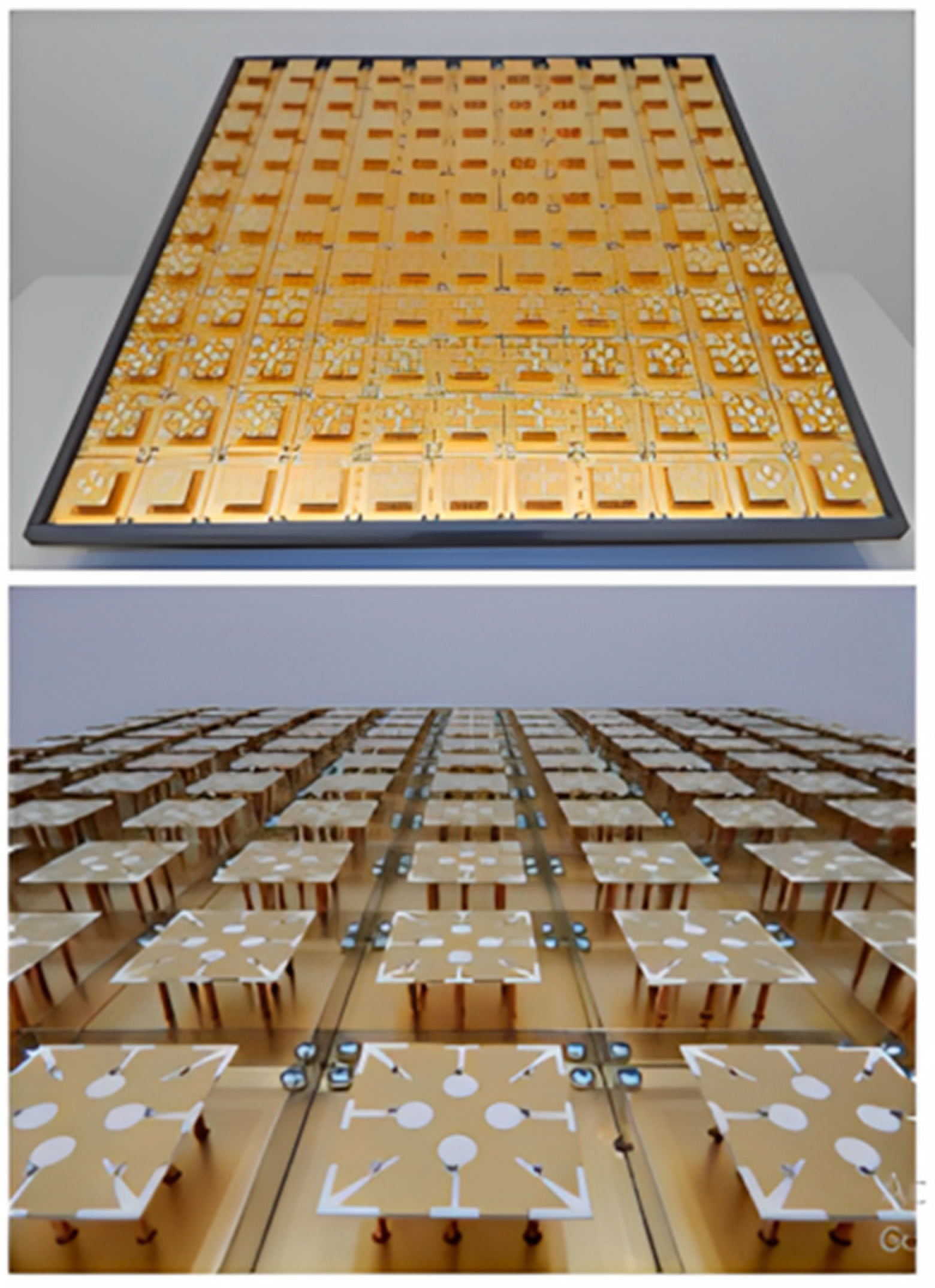

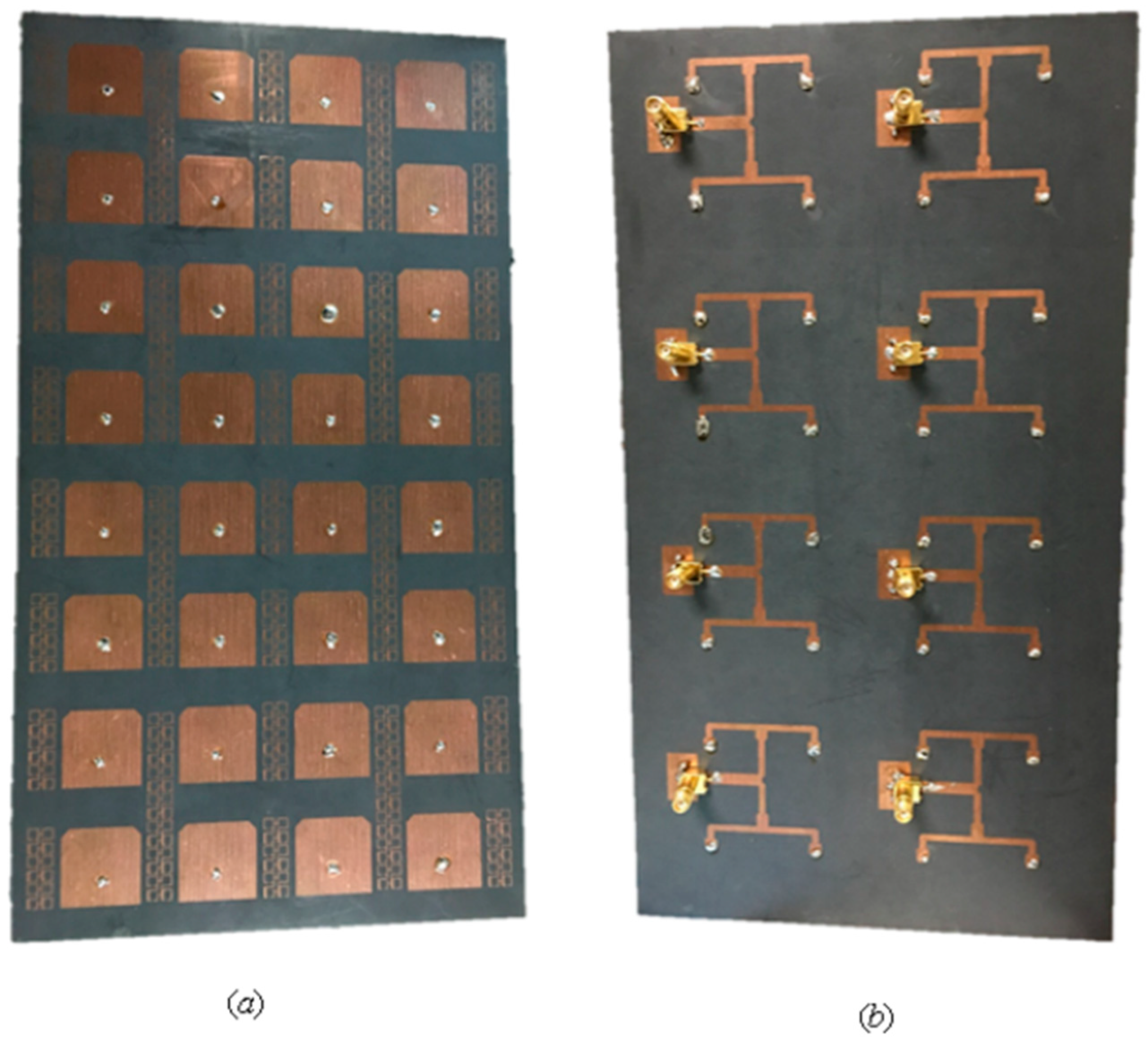

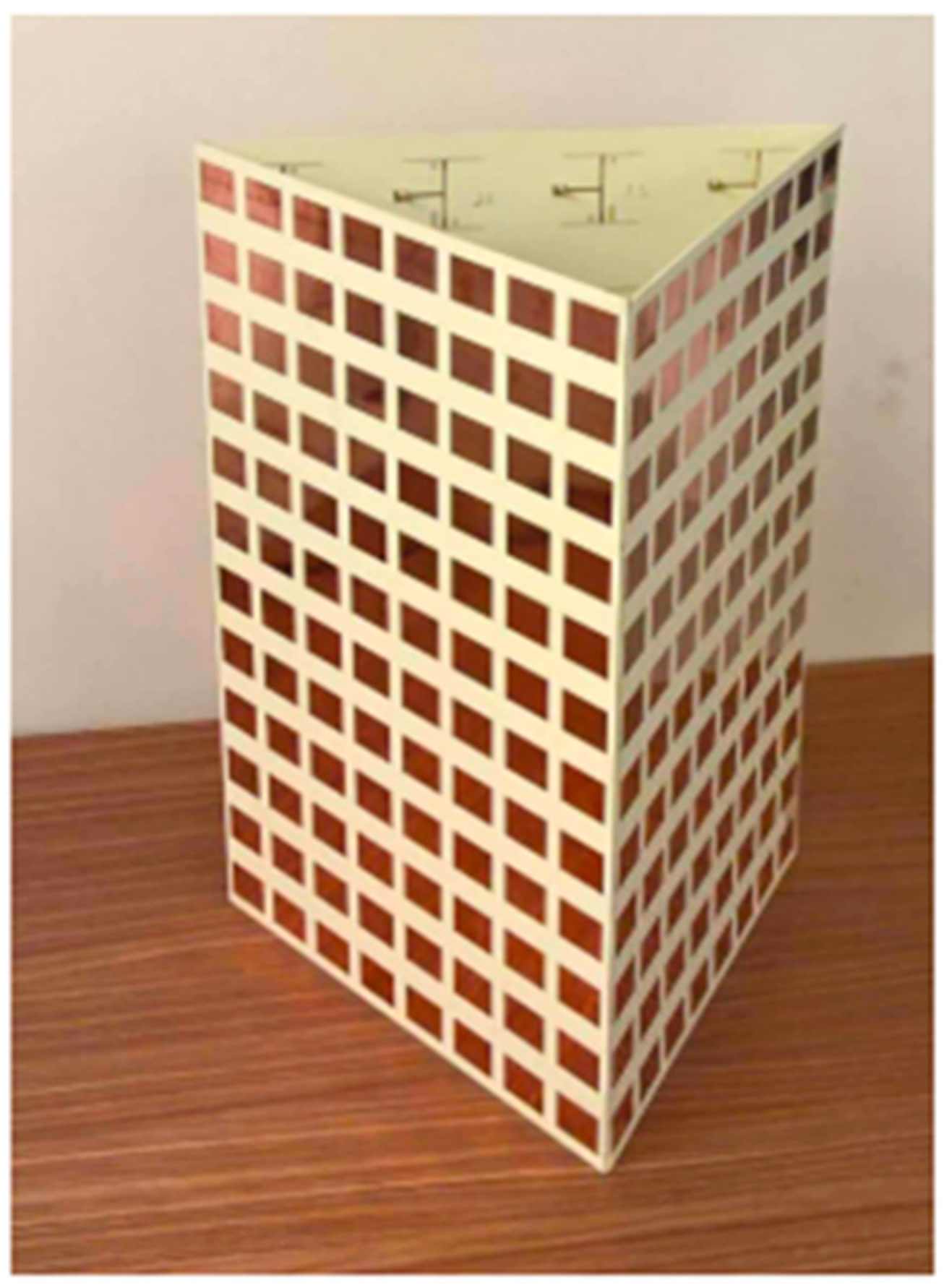
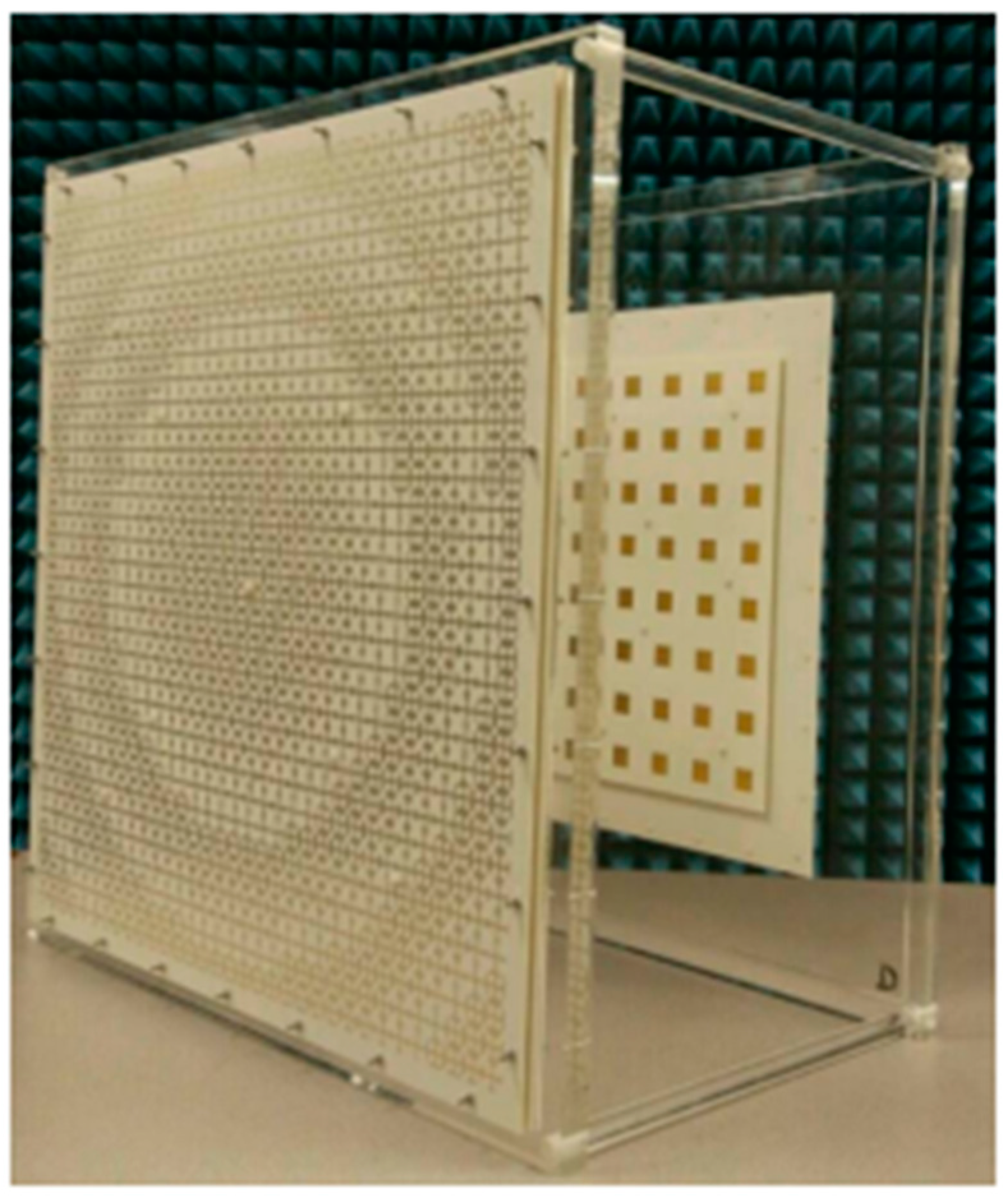
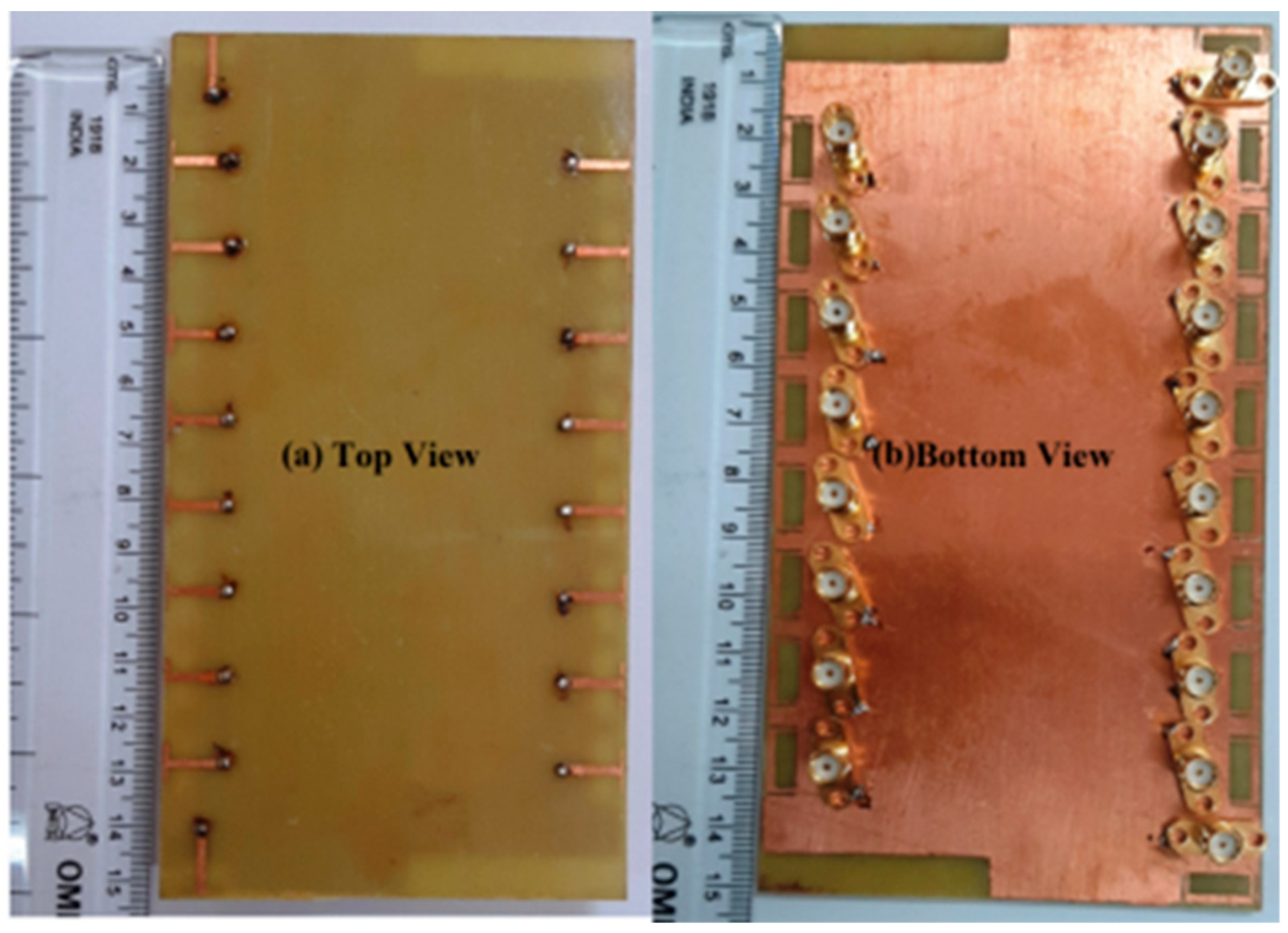
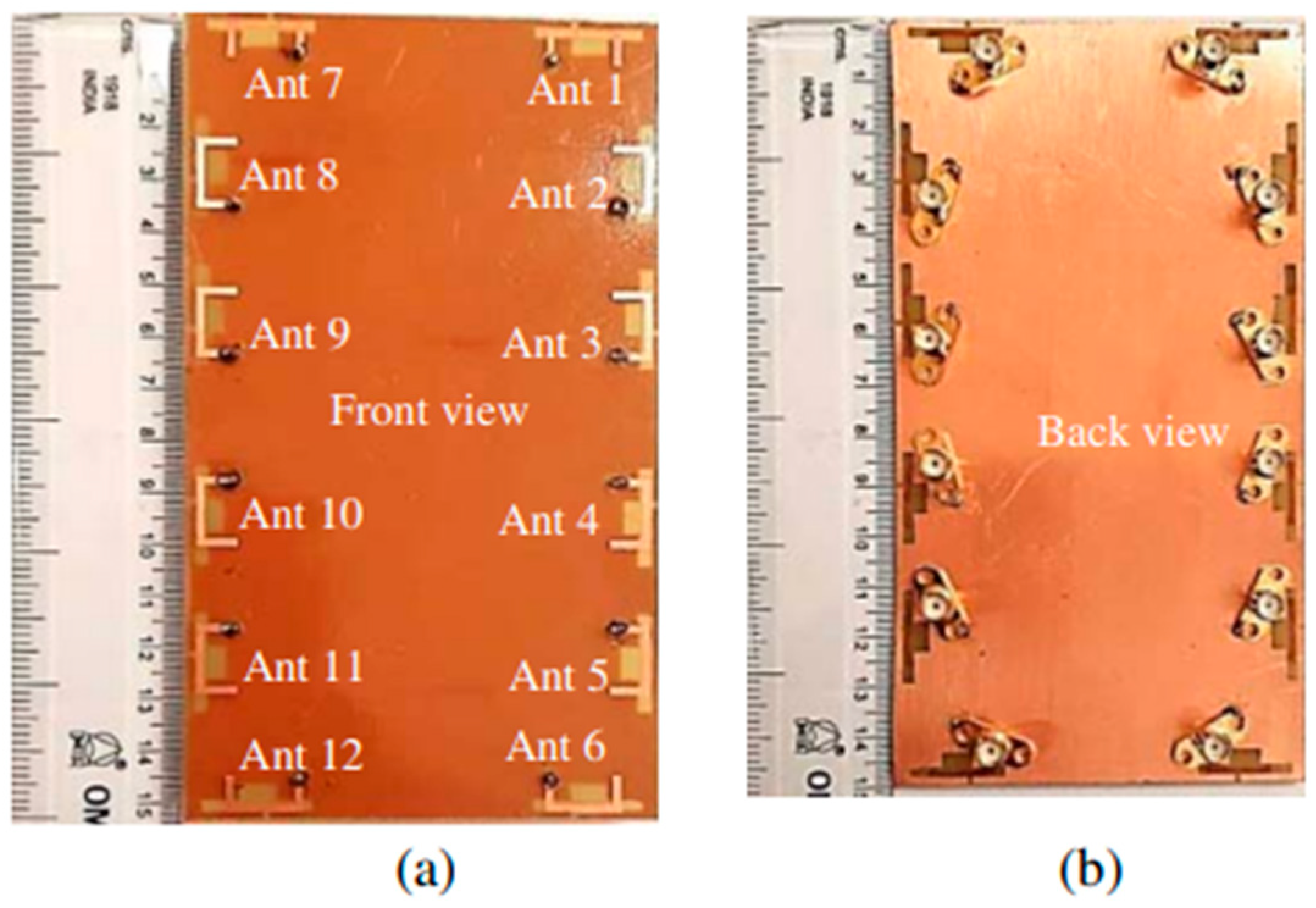
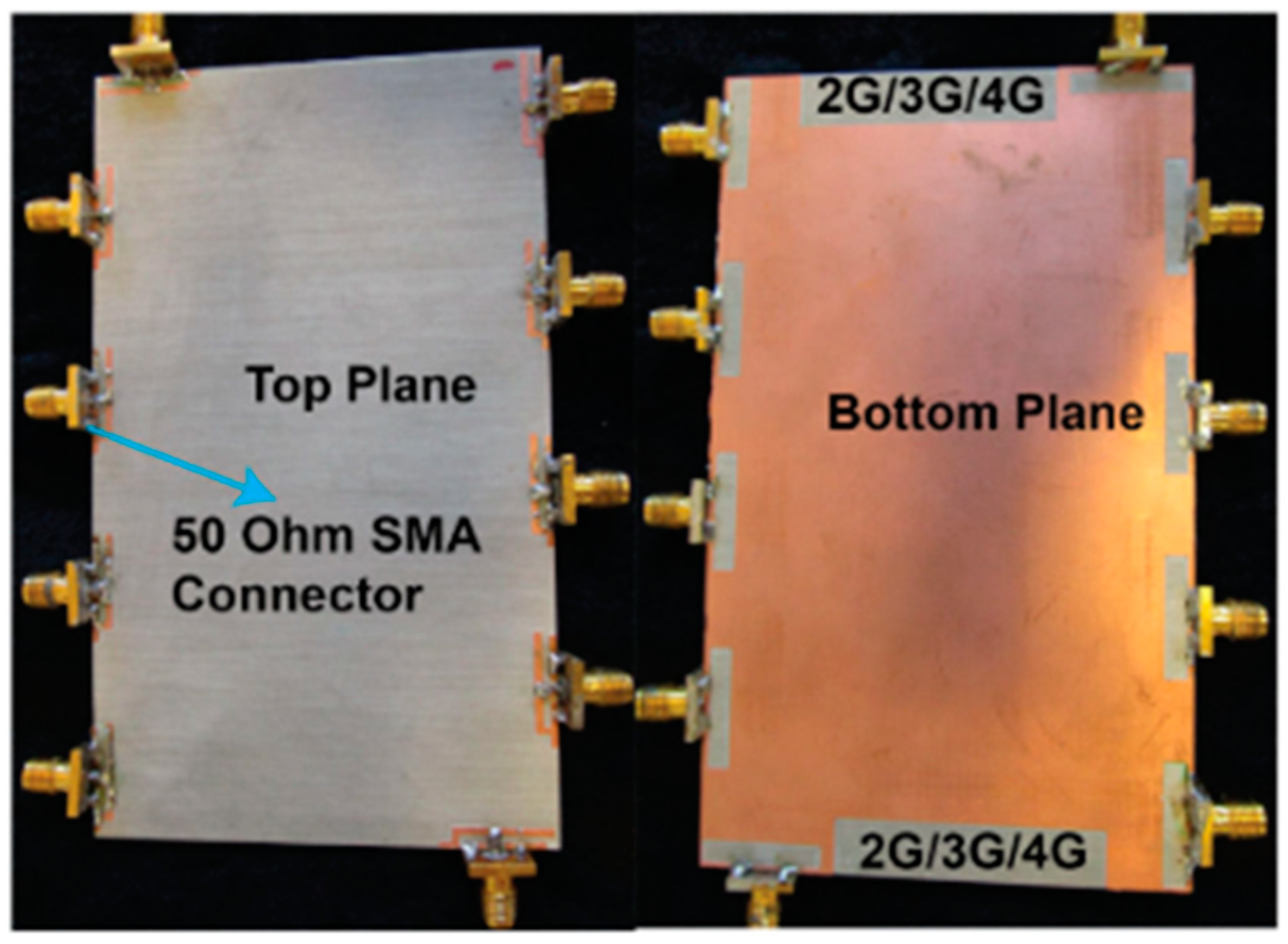


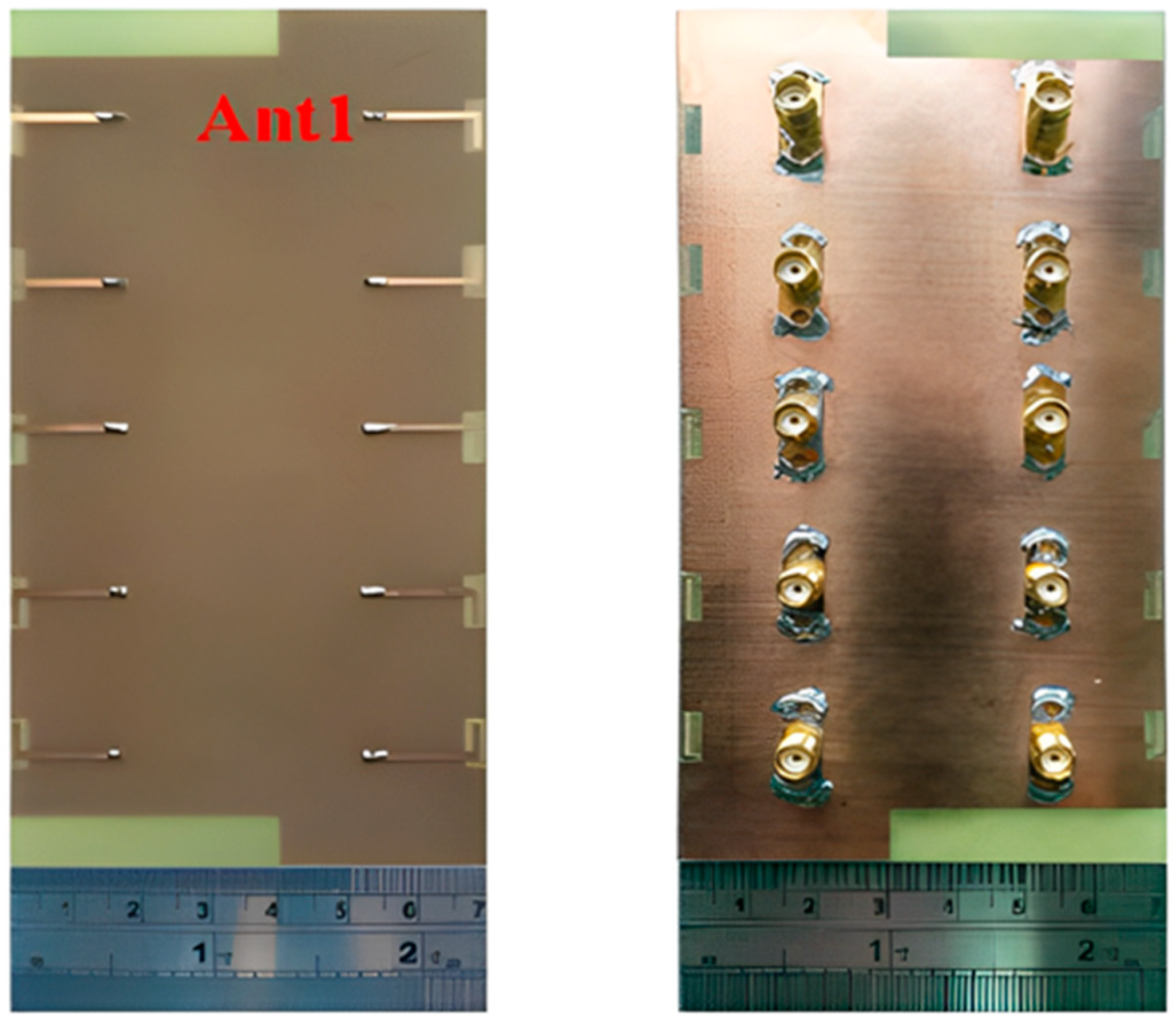
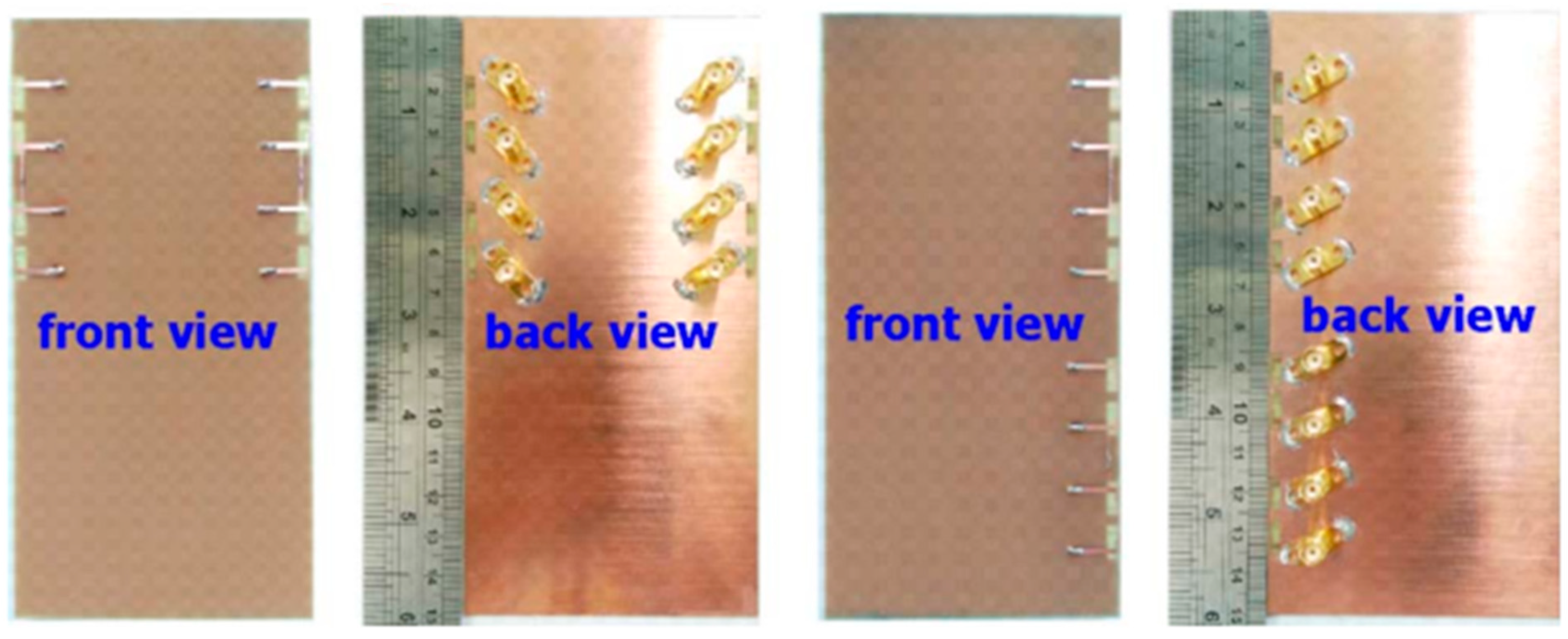
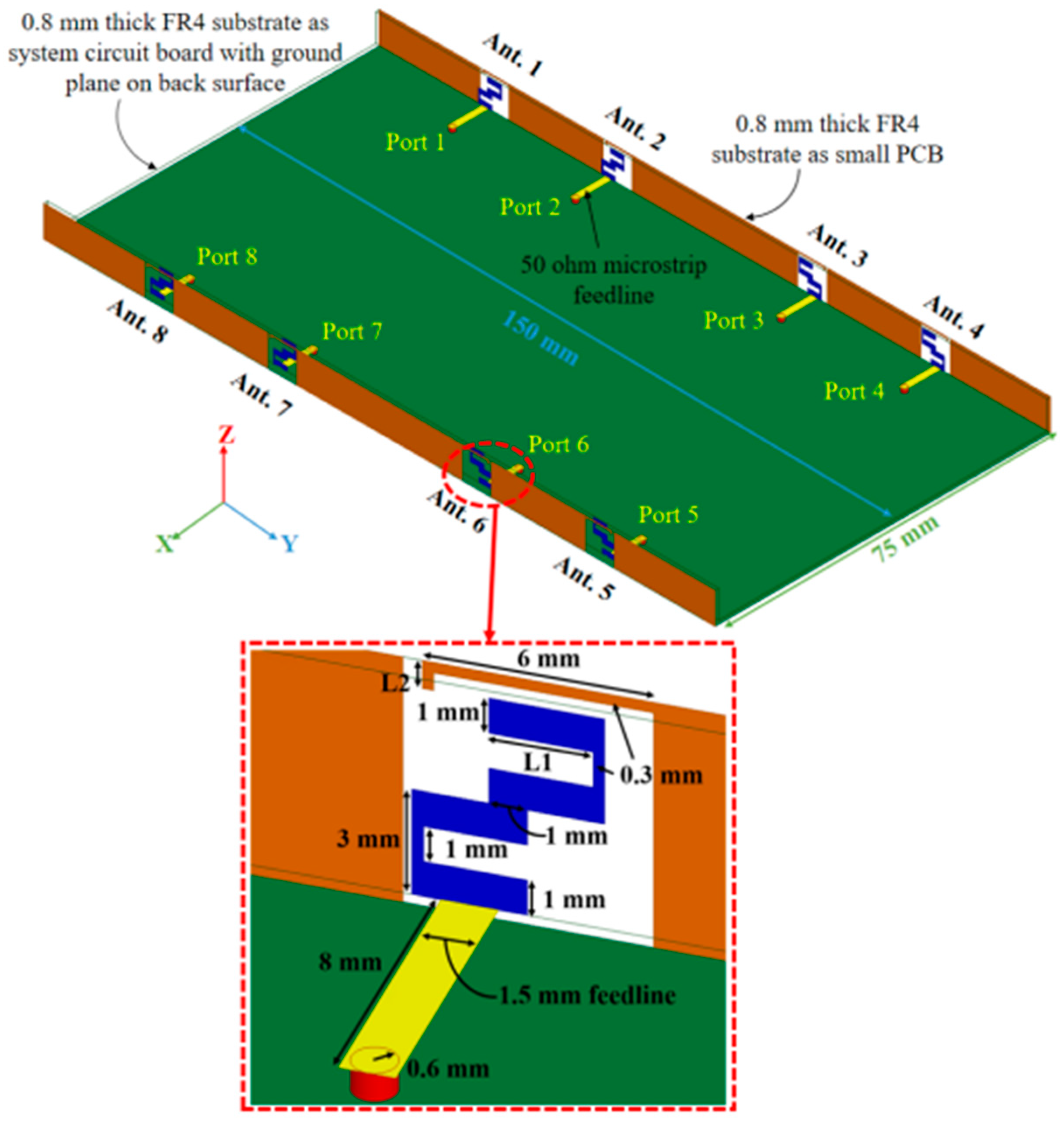


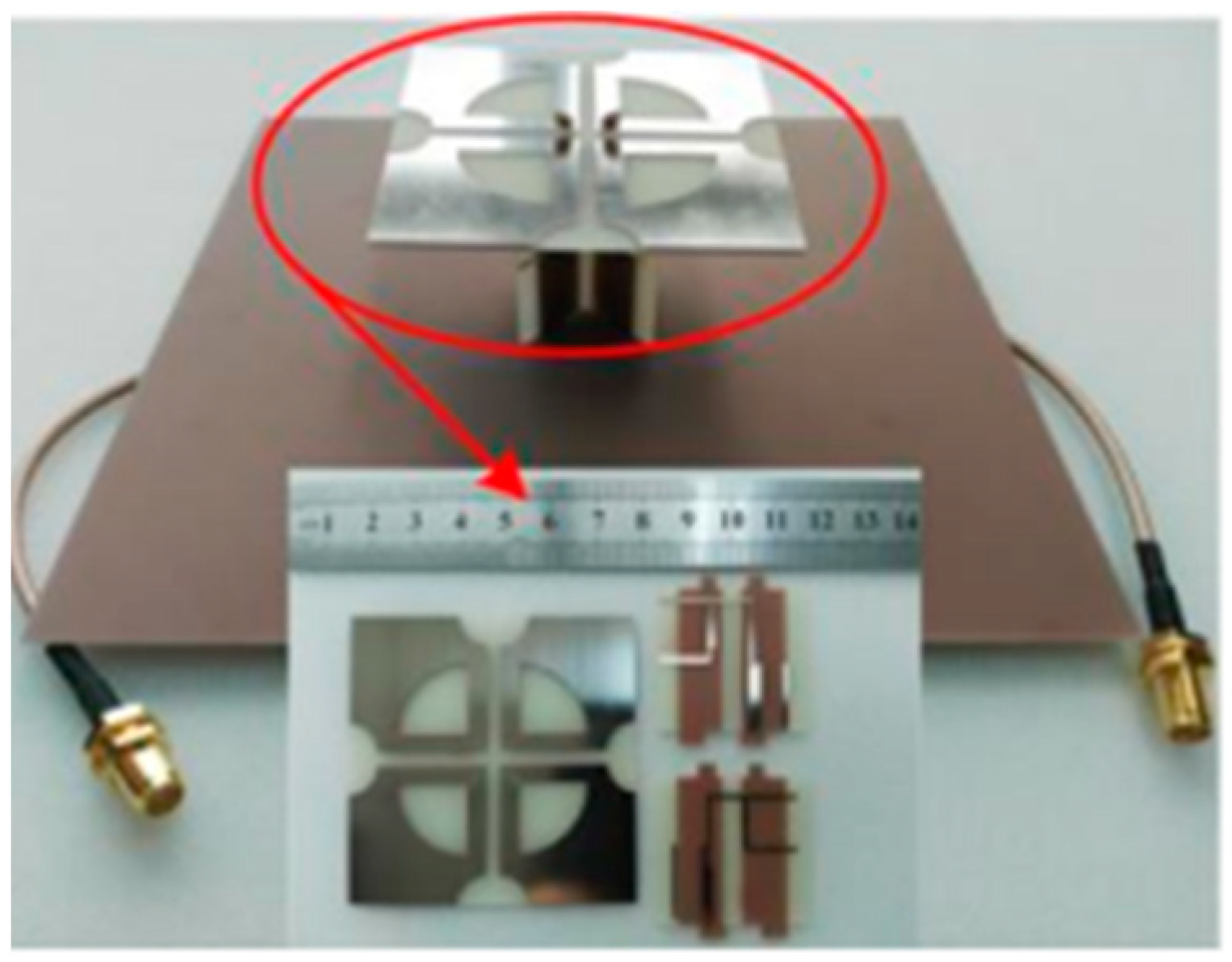
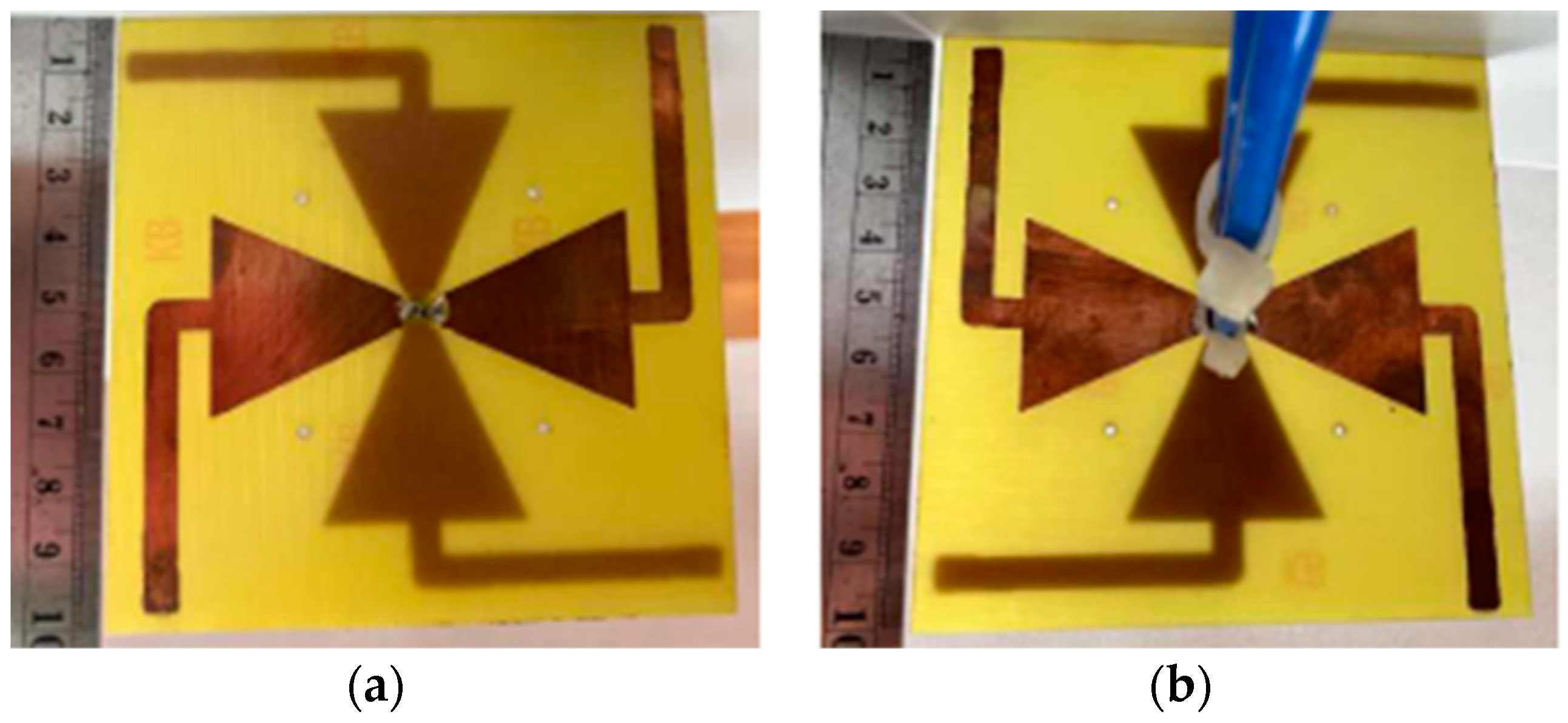


| Ref. | Antenna Schemes | Topology | MIMO Model | Supported Massive Tech. | Enhancements | ||||
|---|---|---|---|---|---|---|---|---|---|
| Compact | B.W | Isolation | Gain | Eff. | |||||
| [28] | UB-FSS-LB | Rectangular | 4 × 4 | Yes |  |  |  |  | |
| [30] | ME dipole-cross patches-dotted slots | Rectangular | 4 × 4 | Yes |  |  | |||
| [32] | Bowtie dipole aerial | Rectangular | 4 × 4 | Yes |  |  |  | ||
| [34] | Patch sub-array | Rectangular | 8 × 8 | Yes |  |  |  | ||
| [35] | Multimode-slotted structure | Rectangular | 11 × 11 | Yes |  |  |  |  | |
| [40] | Patch sub-array | Rectangular, Triangular, Hexagonal | 5 × 4 | Yes |  |  | |||
| [41] | Multimode square patch-stacked polyhedron ring | Ortho-hexagonal | Yes |  |  |  | |||
| [43] | Tapered slot antenna (TSA) | Cylindrical | Yes |  |  |  | |||
| [50] | Square patch with two merged u-slots-dipole | Rectangular | Yes |  | |||||
| [55] | Microstrip patch | Rectangular | 4 × 4 | No |  |  |  | ||
| [56] | Slotted microstrip patch antenna-(NZI-ENG) metamaterial decoupling structure | Cylindrical | No |  |  | ||||
| Ref. | No. of Elements/Ports | Size (mm) | B.W (GHz) | Isolation (dB) | ECC | Gain (dBi) | Eff. (%) |
|---|---|---|---|---|---|---|---|
| [28] | 16/32 | 344 × 344 × 63 | 3.3–5.0 (UB) 0.69–0.96 (LB) | >30 | < 0.1 | 7.3 (UB) 8.6 (LB) | >90 |
| [30] | 16/32 | 90 × 90 × 19.5 (single element) | 3.25–5.35 | - | 0.004 | - | - |
| [32] | 16/32 | 200 × 200 × 32 | 2.8–4.0 | 27 | - | 9.1 | - |
| [34] | 64/16 | 333.3 × 333.3 × 1.6 | 3.45–3.68 | 25 | - | 5.4 (one-port) | 30.887 (one-port) |
| [40] | 20/5 | 280.5 × 56.1 × 2 (single sector) | 3.36–3.5 | 12.3 14.2 13.9 | - | 19.73 (rectangular) 13.45 (triangular) 14.37 (Hexagonal) | - |
| [41] | 288/144 | 648 × 648 × 258 | 3.65–3.81 | >31 | - | 16.7 Sub-array (1×4 ant. units) | - |
| [43] | 24/24 | 280 × 194.4 × 1.6 | 3.0–4.2 | >20 | <0.01 | - | - |
| [50] | 32/32 | 440 × 440 × 1.6 | 2.4–2.62 3.4–3.6 | - | - | 6 (Single Patch) | - |
| Ref. | Antenna Schemes | MIMO Model | Supported Massive Tech. | Enhancements | ||||
|---|---|---|---|---|---|---|---|---|
| Compact | B.W | Isolation | Gain | Eff. | ||||
| [58] | Slot antenna-open ended decoupling slots | 18 × 18 | Yes |  |  |  |  |  |
| [59] | Inverted π-, longer and shorter inverted L-shaped, open slot, antennas | 8 × 8 (LB) 6 × 6 (HB) | Yes |  |  |  | ||
| [60] | Inverted-F stub fed -hybrid loop antenna | 10 × 10 | Yes |  |  |  |  | |
| [61] | T-shaped coupled-fed slot antenna | 10 × 10 | Yes |  |  |  |  | |
| [62] | Planar inverted F-antenna (PIFA) | 8 × 8 | Yes |  |  |  |  | |
| [63] | Switchable frame antenna | 8 × 8 2 × 2 (LB) 6 × 6 (HB) | Yes |  |  |  |  | |
| [64] | Diamond-ring slot antenna | Yes |  |  |  |  |  | |
| [65] | Planar inverted-F antennas (PIFAS) | 18 × 18 16 × 16 14 × 14 12 × 12 10 × 10 8 × 8 | No |  |  |  | ||
| [69] | Two open-end slots—QMSIW antenna | 12 × 12 | No |  |  |  | ||
| [71] | Inverted-F antennas (IFAs) | 10 × 10 | No |  |  |  |  | |
| [74] | Inverted L-shaped monopole | No |  |  |  |  | ||
| [76] | Balanced open slot antenna | 8 × 8 | No |  |  |  | ||
| [77] | Orthogonal-mode dual-antenna pairs-shared radiator | 8 × 8 | No |  |  |  |  | |
| Ref. | No. of Elements/Ports | Size (mm) | B.W (GHz) | Isolation (dB) | ECC | Gain (dBi) | Eff. (%) | PLL (bps/Hz) |
|---|---|---|---|---|---|---|---|---|
| [58] | 18/18 | 150 × 80 × 1.6 | (42/43) 3.4–3.8 | >20 | <0.01 | >5.3 | 87–93 | 81 |
| [59] | 12/12 | 150 × 80 × 0.8 | (42/43/46) 3.4–3.8 5.15–5.925 | >12 | <0.15 0.1 | - | 41–82 47–79 | 37 29.5 |
| [60] | 10/10 | 120 × 70 × 1.52 | (42/43/46) 3.4–3.8 5.15–5.925 | ≥16 ≥15 | ≤0.21 ≤0.15 | - | 82–95 78–96 | 52.5–53.4 52.8–53.9 |
| [61] | 10/10 | 150 × 80 × 0.8 | (42/43/46) 3.4–3.8 5.15–5.925 | >11 | 0.15 0.05 | - | 42–65 62–82 | 48 51.4 |
| [62] | 8/8 | 150×75×1.6 | (42/43/47) 2.5–2.7 3.4–3.8 5.6–6 | >10 | <0.01 | 3–4.5 | 40–80 | - |
| [63] | 8/8 | 150 × 75 × 0.8 | 2.49–2.69 3.38–3.6 | >15.2 | <0.15 | N.A | <68 | <37 |
| Ref. | No. of Elements/ Ports | Type of 5G Antenna | Size (mm) | B.W (GHz) | Return Loss (S11/dB) | Isolation (dB) | Gain (dBi) | Eff. (%) |
|---|---|---|---|---|---|---|---|---|
| [82] | 1/2 | 3D-model | 82 × 82 × 11.8 | 3.14–3.81 | - | >43 | >8.1 | 83 |
| [86] | 1/1 | 3D-model | 75 × 80 × 19 | 3.15–3.67 | 33 | - | 8.2 | - |
| [95] | 1/1 | 2D-model | 43.36 × 35 × 1.575 | 3.392–3.598 | 28.774 | - | 6.58 | 83 |
| [97] | 1/1 | 2D-model | 55 × 40 × 1.6 44 × 30 × 1.6 46 × 26 × 1.6 | 3–4.136 3.14–4.167 3.154–5.31 | 41.31 43.95 20.44 | - | 4.45 4.36 4.42 | >88 |
| [102] | 4/4 | Symmetric sub-array | 129.5 × 129.5 × 28.2 | 1.55–6 | - | 16 | - | 84 |
| [106] | 4/4 | Symmetric sub-array | 120 × 65 × 1.6 | 3.3–5 | - | 18.8 | 4.71 | - |
| [110] | 3/6 | Non-symmetric sub-array | 160 × 16 × 35 (Single ant.) | 1.63 to 3.73 3.4–3.6 | - | 25 | 12.9 17.3 | - |
| [114] | 8/16 | Non-symmetric sub-array | 95 × 455 × 11 | 3.3–5.9 | 15 | 28–30 | - | - |
Disclaimer/Publisher’s Note: The statements, opinions and data contained in all publications are solely those of the individual author(s) and contributor(s) and not of MDPI and/or the editor(s). MDPI and/or the editor(s) disclaim responsibility for any injury to people or property resulting from any ideas, methods, instructions or products referred to in the content. |
© 2023 by the authors. Licensee MDPI, Basel, Switzerland. This article is an open access article distributed under the terms and conditions of the Creative Commons Attribution (CC BY) license (https://creativecommons.org/licenses/by/4.0/).
Share and Cite
Ibrahim, S.K.; Singh, M.J.; Al-Bawri, S.S.; Ibrahim, H.H.; Islam, M.T.; Islam, M.S.; Alzamil, A.; Abdulkawi, W.M. Design, Challenges and Developments for 5G Massive MIMO Antenna Systems at Sub 6-GHz Band: A Review. Nanomaterials 2023, 13, 520. https://doi.org/10.3390/nano13030520
Ibrahim SK, Singh MJ, Al-Bawri SS, Ibrahim HH, Islam MT, Islam MS, Alzamil A, Abdulkawi WM. Design, Challenges and Developments for 5G Massive MIMO Antenna Systems at Sub 6-GHz Band: A Review. Nanomaterials. 2023; 13(3):520. https://doi.org/10.3390/nano13030520
Chicago/Turabian StyleIbrahim, Sura Khalil, Mandeep Jit Singh, Samir Salem Al-Bawri, Husam Hamid Ibrahim, Mohammad Tariqul Islam, Md. Shabiul Islam, Ahmed Alzamil, and Wazie M. Abdulkawi. 2023. "Design, Challenges and Developments for 5G Massive MIMO Antenna Systems at Sub 6-GHz Band: A Review" Nanomaterials 13, no. 3: 520. https://doi.org/10.3390/nano13030520
APA StyleIbrahim, S. K., Singh, M. J., Al-Bawri, S. S., Ibrahim, H. H., Islam, M. T., Islam, M. S., Alzamil, A., & Abdulkawi, W. M. (2023). Design, Challenges and Developments for 5G Massive MIMO Antenna Systems at Sub 6-GHz Band: A Review. Nanomaterials, 13(3), 520. https://doi.org/10.3390/nano13030520









